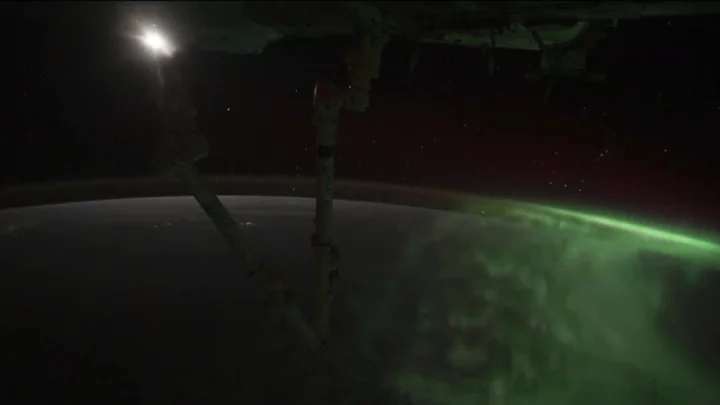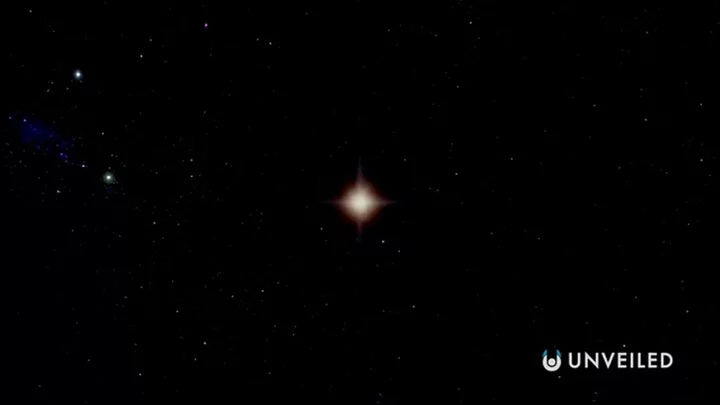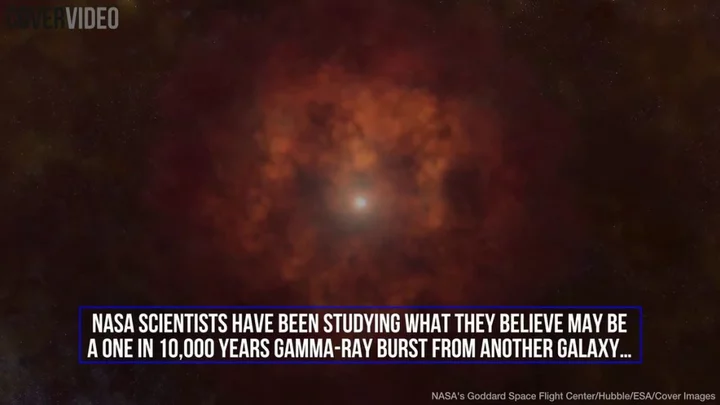
Earthbound solar storm could cause 'internet apocalypse'
Rumours of a global internet outage due to a severe solar storm have been swirling online, but how true are they? With plenty of us relying on internet access on a daily basis for our work, entertainment and communication needs, the rumour of an internet apocalypse has left many worried. Throughout June, the possibility that we could lose internet for months has been spreading. But, the very possibility first gained public attention back in 2021 when computer scientist Sangeetha Abdu Jyothi at the University of California Irvine warned that a catastrophic solar storm could occur within the next 10 years. Sign up to our free Indy100 weekly newsletter It seems the space agency NASA is taking the risk seriously and launched the Parker Solar Probe (PSP) which revealed clues about the sun’s atmosphere after successfully navigating through the powerful solar winds generated there. What is a solar storm and how could it cause an internet apocalypse? A solar storm refers to the atmospheric effects we experience on Earth that originate from the sun, typically caused by solar flares. During such storms, a stream of an electromagnetic field is directed towards Earth which causes the aurora borealis. NASA believes solar storms run on an 11-year cycle with their frequency varying. Their severity can also vary, with stronger geomagnetic storms causing interruptions to satellite, radio and internet functions. A 2011 geomagnetic storm interrupted radio signals in South China, meanwhile in 1859 a particularly intense storm caused auroras to appear in the skies all around the world. Should such an event strike today, there could be a worldwide blackout causing disruption for months, with its effects predicted to be 20 times that of a catastrophic hurricane due to its impact on the supply chain of essentials like foods and medication. Have your say in our news democracy. Click the upvote icon at the top of the page to help raise this article through the indy100 rankings.
2023-06-27 18:17

Zalando sues EU Commission over landmark online content rules
By Foo Yun Chee BRUSSELS Zalando, Europe's biggest online fashion retailer, on Tuesday sued the European Commission for
2023-06-27 15:28

Human babies can be born with 'tails' – and it's not a cute quirk of evolution
How would you feel if you gave birth to a beautiful newborn, only to clock they have a tail? It sounds outlandish, but it can happen in very rare cases when humans can be born with these boneless rear-end appendages, which are sometimes up to 18 centimetres long. To date, official records have tallied about 40 babies born with these 'tails' which are easily removed through surgery. So how does it happen? Experts used to think the tails were evolutionary accidents, leftovers from our primate ancestors. Sign up to our free Indy100 weekly newsletter But thanks to research, experts have realised they probably come from an incomplete fusion of the spinal column, or what's known as a spinal dysraphism. Human babies that are born with tails tend to have serious associated neurological defects. In 2008, a paper argued that "true vestigial tails are not benign" because they may be associated with underlying dysraphism. Roughly half of the cases reviewed were associated with either meningocele or spina bifida occulta. So it is not just a harmless evolutionary quirk after all, but more research needs to be done, scientists say. Have your say in our news democracy. Click the upvote icon at the top of the page to help raise this article through the indy100 rankings.
2023-06-27 00:20

Here's how much each state will get in the $42.5 billion broadband infrastructure plan
The Biden administration on Monday outlined how states across the country will be receiving billions of dollars in federal funding for high-speed internet access, highlighting the US government's push to bring connectivity to more Americans and to close the digital divide.
2023-06-27 00:16

Former Apprentice star bares all in ‘world’s largest AI-generated billboard'
A man known for flying 4,000 miles to track down a thief who stole his AirPods is at it again – and this time, he’s baring all. With artificial intelligence technology on the rise, former Apprentice contestant, Lewis Ellis, is on a mission to find out if robots are going to come for our jobs. In a bizarre experiment, the 32-year-old, who is no stranger to unusual projects – having previously auctioned off his bum cheek for the highest bidder to choose a tattoo – he used ChatGPT to re-create an image for a billboard. And the result is hilarious. The giant billboard, featured at Victoria Warehouse in Lewis' hometown of Manchester, shows the entrepreneur stark naked – as a mermaid. Sign up to our free Indy100 weekly newsletter He used the famous Burt Reynolds Cosmo centre-fold for the main image and asked ChatGPT to “create the content”. ”Whatever it creates, that goes live,” Lewis says in a YouTube video. “I’m not sure if it’s is a good idea, I’m not sure if it’s going to be a complete waste of time but I guess we’ll find out.” Measuring in at 17.6m x 17.4 billboard, it is believed to be the second largest in Europe – however Lewis believes it is the “world’s largest AI-generated billboard. The Apprentice star photoshops his face and tattoos onto the nude Reynolds. The billboard went live at 9am on Wednesday (21 June) and… it’s definitely interesting. Lewis said: ”I was silly to assume that AI would pull it together for me – I won’t really have to do much. ”Turns out it's way harder than I thought. ”And it looks so bad.” The sorry-looking AI generated advert morphed the image of Lewis and Burt Reynolds into the sea creature. In the background, there is a cartoon drawing of a lighthouse and beach. The sign reads: “Feast your eyes on this tragic masterpiece. ”The world’s largest AI-generated billboard. ”AI is going to take over the world. ”That may be true… but it’s not going to be today.” The billboard ad is a recreation of his company, Hussel Marketing’s previous marketing campaign. Lewis took his inspiration for the experiment from the likes of McDonald's, Burger King and Subway, with the brands using ChatGPT for recent ads. To make it even harder, he gave himself just 24 hours to complete the challenge. The entrepreneur certainly isn’t shy in pushing the boundaries of what is possible and using technology to do so. In the past, he has shelled out £2,300 on flights, accommodation and food to fly 4,000 miles to track down his headphones, saying his mum describes him as “mental”. He told Jam Press: “We had no real plan but just hoped to find them again. “The fact you can track tiny headphones around the world is unbelievable. “I didn’t really expect to get them back and I joked that flying to Doha to get them is the pettiest thing I’ve ever done. “But it’s just great that we managed to find them – and now I don’t need to buy a new pair!” What does the marketing guru have up his sleeve next? It’s anyone’s guess. But one thing is certain – AI bots aren’t going to take over his job just yet. Have your say in our news democracy. Click the upvote icon at the top of the page to help raise this article through the indy100 rankings.
2023-06-26 23:29

Scientists have solved a great mystery at the dawn of time itself
Many of us will never get our heads around the fact that scientists can actually look back in time. The power of telescopes enables us to study phenomena that occurred billions of years ago, and even gaze upon the dawn of creation itself. Now, astrophysicists have solved a great mystery at the heart of our universe's birth, when everything was shrouded in a dense fog. In four separate papers published in (or accepted into) The Astrophysical Journal, scientists at MIT, Japan’s Nagoya University, ETH Zurich and the University of Groningen in the Netherlands have shared some stunning insights into the period known as the Epoch of Reionisation. Sign up for our free Indy100 weekly newsletter Relatively little is known about this era, during which the thick fog engulfing the universe gradually cleared, allowing stars and galaxies to shine. However, fresh observations made using the James Webb Space Telescope (JWST) are beginning to pull back the curtain on it all. Now, scientists have finally figured out why one billion years after the Big Bang, that dense fog finally dispersed. First things first, what exactly is the Epoch of Reionisation? During the first billion years after the Big Bang, space was filled with a soupy mist of ionised gas which was impenetrable to light. As the gas began to cool, protons and electrons began to combine to form mostly neutral hydrogen atoms and some helium. These clumps of neutral hydrogen are then believed to have started forming stars, grouped into galaxies. This process reionised the gas but, because space had expanded by this point, the newly ionised hydrogen was diffuse enough to allow light to stream through, as Science Alert notes. A few million years later, the universe had become the transparent expanse with which we’re now familiar. To explain, here’s a look at what those four new papers reveal about why space became so much clearer. Paper 1 In the first study, researchers at the University of Groningen revealed that they had discovered crucial evidence of star formation during the Epoch of Reionisation. They found a specific wavelength of hydrogen, called hydrogen alpha, which is formed when a star is born and blasts out huge amounts of ionising ultraviolet radiation. Until now, no one was sure what produced all the ultraviolet light that emerged during the Epoch of Reionisation. But, thanks to their detection of hydrogen alpha, the Groningen team of astronomers that star formation had a “significant role in the process of reionisation”. Paper 2 Another paper, spearheaded by Japanese astrophysicist Daichi Kashino, added galaxies into the mix. According to Kashino and his international team, reionisation happened in “bubbles” around the plethora of newly-formed galaxies. They used JWST data to pinpoint these pockets and measure them precisely, identifying that they had a 2 million light-year radius around the tiny galaxies. Over the next hundred million years, the bubbles grew larger and larger, eventually merging and causing the entire universe to become transparent, according to an article published by NASA. Paper 3 A third group of researchers, led by ETH Zurich astrophysicist Jorryt Matthee, analysed the characteristics of these bubbles and found that the early galaxies they contained were hot, low in metals and dust and very active. He said they were “more chaotic” than those in the nearby universe, adding: "Webb shows they were actively forming stars and must have been shooting off many supernovae. They had quite an adventurous youth!” Paper 4 A fourth paper, led by MIT cosmologist Anna-Christina Eilers, focused its attention on the quasar galaxy at the centre of the JWST observations. This quasar is, according to NASA, an “extremely luminous active supermassive black hole that acts like an enormous flashlight”. Eilers and her team used data from the telescope to confirm that the black hole is the most massive currently known in the early universe, weighing 10 billion times the mass of the Sun. “We still can’t explain how quasars were able to grow so large so early in the history of the universe,” she said. “That’s another puzzle to solve!” Conclusion Well done if you’ve survived to the end – this is all pretty heavy-going. But the key point here is that before the JWST no one knew for sure what caused reionisation. Now, thanks to the mighty golden-eyed telescope, one of the great mysteries behind the birth of creation has finally been solved. Have your say in our news democracy. Click the upvote icon at the top of the page to help raise this article through the indy100 rankings.
2023-06-26 22:53

Sweden will have a city made of wood built in the next four years
Sweden is set to have the "world's largest wooden city" with plans for the development in Stockholm. Danish studio Henning Larsen and Swedish architecture firm White Arkitekter are the studios behind the design that will be constructed in the Sickla area of the city. It will use the largest amount of fire-proofed mass timber in a project of this kind with 7,000 office spaces and 2,000 homes, along with shops and restaurants being built. Sign up to our free Indy100 weekly newsletter This amount of wood will be used to cover the 250,000 square metre development to display the "serenity of a forest" and natural elements will also be part of the buildings. "We sought to create an urban environment infused with the serenity of a forest, resulting in a dense, open space that bears the distinctively minimalistic and functional aesthetic of Scandinavian design," Atrium Ljungberg told Dezeen. "The architects innovatively incorporated natural elements into the structures – for instance, green roofs for better insulation and large windows to let in natural light, embodying our vision of a city that thrives in harmony with nature." The environmental benefits of using this wooden material were noted too as it emits fewer emissions than concrete as well as a reduced climate impact during and after its construction. The project is planned to get underway in 2025, with the first buildings being completed two years later. Have your say in our news democracy. Click the upvote icon at the top of the page to help raise this article through the indy100 rankings.
2023-06-26 21:49

Why you should never drain your pasta in the sink
Pasta lovers are often guilty of draining their pasta water down the sink before adding sauce. But there is an important reason to save your pasta water and it is pretty scientific. Because pasta is made of flour, it releases starch into the cooking water as it boils, creating a white, cloudy liquid that emulsifies sauces it is added to. Emulsification is the process of blending two liquids that would otherwise repel each other ― in the case of pasta, it’s oil and water ― into a smooth, inseparable mixture. Sign up to our free Indy100 weekly newsletter Starchy pasta water is also a thickener, so saving some and mixing it into sauce creates something creamy and thick that won’t ever separate. This makes for a better sauce, so if you ladle some pasta water out before draining the rest you are going to be giving serious chef vibes. With that said, it is time to impress everyone you ever cook for again - just from the simple act of saving a small bit of water. Have your say in our news democracy. Click the upvote icon at the top of the page to help raise this article through the indy100 rankings.
2023-06-26 20:18

Astronomers discover a totally new way that stars can die
Astronomers have discovered a new way that stars can die. In a study published in the journal Nature Astronomy, experts have worked out that a minute-long gamma-ray burst of light, which occured in 2019 and evidence a star dying, happened because stars collided within the densely crowded environment near the supermassive black hole at the centre of an ancient galaxy. Normally gamma-ray bursts (GRB) last around two seconds and happen when stars collapse. “For every hundred events that fit into the traditional classification scheme of gamma-ray bursts, there is at least one oddball that throws us for a loop,” said study coauthor Wen-fai Fong, assistant professor of physics and astronomy at Northwestern University’s Weinberg College of Arts and Sciences, in a statement. “However, it is these oddballs that tell us the most about the spectacular diversity of explosions that the universe is capable of.” Over time, astronomers have observed three main ways that stars can die, depending on their size. Lower mass stars like our sun shed their outer layers as they age, eventually becoming dead white dwarf stars. Sign up to our free Indy100 weekly newsletter Massive stars burn through the fuel-like elements at their core and shatter in explosions called supernovas. Doing so can leave behind dense remnants like neutron stars or result in the creation of black holes. A third form of star death results when neutron stars or black holes begin to orbit one another in a binary system and spiral closer to one another until they collide and explode. But the new observation suggests a fourth type of death. “Our results show that stars can meet their demise in some of the densest regions of the universe, where they can be driven to collide,” said lead study author Andrew Levan, an astrophysics professor at Radboud University in Nijmegen, Netherlands, in a statement. “This is exciting for understanding how stars die and for answering other questions, such as what unexpected sources might create gravitational waves that we could detect on Earth.” “The lack of a supernova accompanying the long GRB 191019A tells us that this burst is not a typical massive star collapse,” said study coauthor Jillian Rastinejad, a doctoral student of astronomy at Northwestern, in a statement. “The location of GRB 191019A, embedded in the nucleus of the host galaxy, teases a predicted but not yet evidenced theory for how gravitational-wave emitting sources might form.” “While this event is the first of its kind to be discovered, it’s possible there are more out there that are hidden by the large amounts of dust close to their galaxies,” said Fong, who is also a member of the Center for Interdisciplinary Exploration and Research in Astrophysics at Northwestern. “Indeed, if this long-duration event came from merging compact objects, it contributes to the growing population of GRBs that defies our traditional classifications.” You learn something new every day. Have your say in our news democracy. Click the upvote icon at the top of the page to help raise this article through the indy100 rankings.
2023-06-26 19:26

Biden to detail plans for $42 billion investment in US internet access
By Jarrett Renshaw U.S. President Joe Biden on Monday plans to lay out how a $42 billion investment
2023-06-26 17:18

Scientists have come up with a new meaning of life – and it's pretty mind-blowing
The meaning of life is the ultimate mystery – why do we exist? And is there a point to… well… anything? These are questions to which we may never find answers, but at least we can define what “life” means in scientific terms. And yet, our understanding of what life is is changing all the time, thanks to space exploration. As scientists continue to hunt for life beyond our own world, biologists are having to rethink the meaning of the word “life” itself. Sign up for our free Indy100 weekly newsletter Generally, biologists explain “life” as connoting a self-sustaining chemical system which is capable of performing functions such as eating, metabolising, excreting, breathing, moving, growing, reproducing, and responding to external stimuli. This definition works pretty well here on Earth (although there are some important exceptions, such as viruses), but experts have pointed out that if life exists elsewhere in the universe, it may not display the same properties that we’re used to. Indeed, it might be unrecognisable as life as we know it (forget those little green men). In which case, how will we spot it if it ever crosses our path? Astrobiologist Sara Imari Walker and chemist Lee Cronin think they’ve come up with a solution. The pair are now arguing that highly complex molecules found in all living creatures can’t exist thanks purely to chance. Therefore, they say, the universe must have a way of creating and reproducing complex information and retaining a “memory” of all of this.. In an interview with New Scientist, Walker, of Arizona State University, explained their radical idea on how objects come into existence. The concept, known as Assembly Theory, explains why certain complex objects have become more abundant than others by considering their histories. If the theory proves correct, it will redefine what we mean by “living” things and show that we’ve been going about the search for extraterrestrial life all wrong. In the process, we could even end up creating alien life in a laboratory, she stressed. In her discussion with New Scientist, Walker pointed out: "An electron can be made anywhere in the universe and has no history. You are also a fundamental object, but with a lot of historical dependency. You might want to cite your age counting back to when you were born, but parts of you are billions of years older. "From this perspective, we should think of ourselves as lineages of propagating information that temporarily finds itself aggregated in an individual." Assembly theory predicts that molecules produced by biological processes must be more complex than those produced by non-biological processes, as Science Alert notes. To test this, Walker and her team analysed a range of organic and inorganic compounds from around the world and outer space, including E. coli bacteria, urine, meteorites and even home-brewed beer. They then smashed up the compounds into smaller pieces and used mass spectrometry to pinpoint their molecular building blocks. They calculated that the smallest number of steps required to reassemble each compound from these building blocks was 15. And whilst some compounds from living systems needed fewer than 15 assembly steps, no inorganic compounds made it above this threshold. "Our system … allows us to search the universe agnostically for evidence of what life does rather than attempting to define what life is," Walker, Cronin, and others wrote in a 2021 Nature Communications article. The handy thing about this building block system – which they’ve dubbed the “'molecular assembly index” – is that it doesn’t rely on carbon-based organic materials to be identified. In other words, an alien could be made of entirely different stuff entirely and we’d still be able to spot it as life using the index. It also works regardless of what stage of “life” an extraterrestrial being is in – whether it is still in its infancy or has moved into a technological stage beyond our understanding. That’s because all of these states produce complex molecules which couldn’t exist in the absence of a living system. If all of this is hurting your head, let’s just get back to the basics: if there is a secret to life, it might all be down to what we do, not what we are. Have your say in our news democracy. Click the upvote icon at the top of the page to help raise this article through the indy100 rankings.
2023-06-25 19:17

Heartbeat sensors on shopping trolleys 'could save lives', new study suggests
New findings have suggested that adding sensors to supermarket trolleys could save people’s lives. Scientists investigated whether installing electrocardiogram (ECG) sensors – designed to check the heart’s rhythm – on the handles of supermarket, trolleys could identify shoppers with atrial fibrillation, which causes an irregular and often abnormally fast heart rate. The sensors would detect heart conditions that put them at increased risk of stroke. The researchers said that over the course of two months, they identified 39 people who were unaware that they had the condition. Ian Jones, professor of cardiovascular nursing at Liverpool John Moores University, who led the study, said: “That’s 39 people at greater risk of stroke who received a cardiologist appointment.” He added: “This study shows the potential of taking health checks to the masses without disrupting daily routines.” It is estimated that around 1.5 million people in the UK have atrial fibrillation, contributing to one in five strokes. The condition is treatable, but at least another 270,000 people in the UK remain undiagnosed and unaware, according to the British Heart Foundation. Sign up for our free Indy100 weekly newsletter There are wearable devices that can also spot irregular heartbeat but this would also require people to take responsibility and wear the device. Professor Jones said: “Nearly two-thirds of the shoppers we approached were happy to use a trolley, and the vast majority of those who declined were in a rush rather than wary of being monitored. “This shows that the concept is acceptable to most people and worth testing in a larger study.” He added: “Checking for atrial fibrillation while people do their regular shopping holds promise for preventing strokes and saving lives. “A crucial aspect is providing immediate access to a health professional who can explain the findings and refer patients on for confirmatory tests and medication if needed.” The findings were presented at ACNAP 2023 conference organised by the European Society of Cardiology (ESC). Have your say in our news democracy. Click the upvote icon at the top of the page to help raise this article through the indy100 rankings.
2023-06-25 16:59
